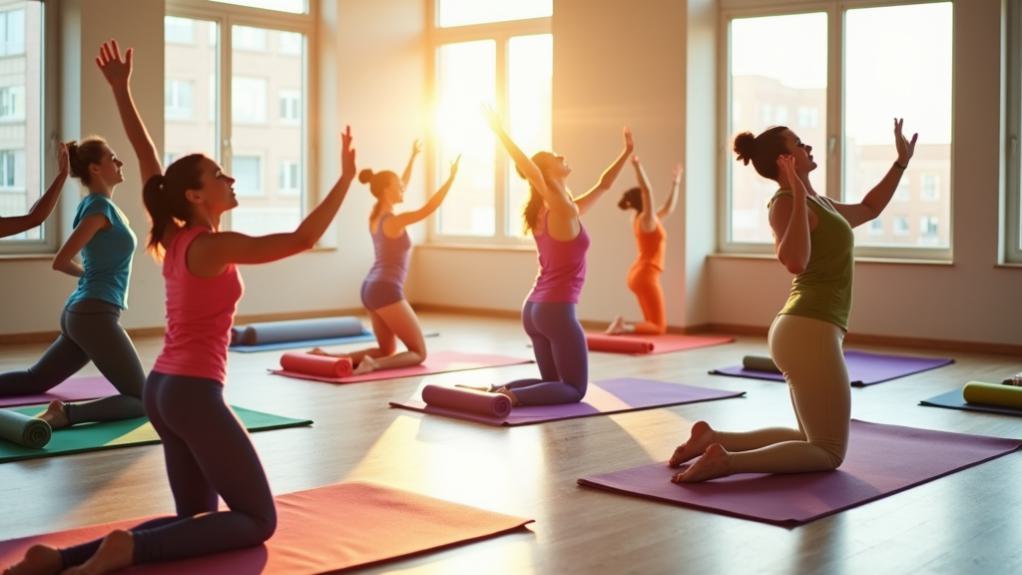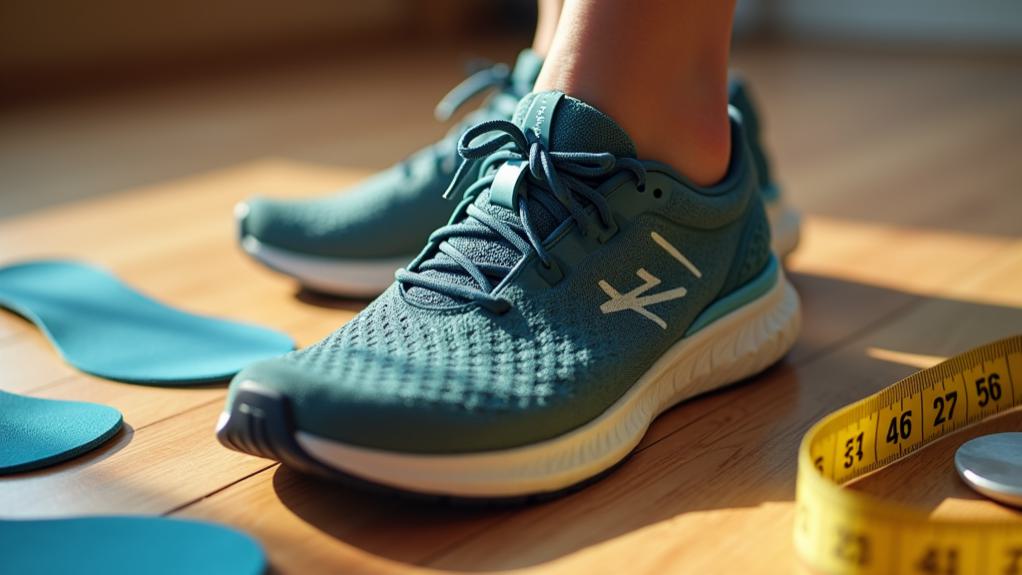To avoid common exercise injuries in midlife, prioritize safety and start slow. Always warm up to boost blood flow and flexibility. Focus on building strength and balance, particularly in your core and lower body, to reduce fall risks. Choose appropriate footwear to prevent issues like shin splints. Listen to your body; if you feel fatigue or sharp pain, adjust your routine. Consider hiring a personal trainer for tailored guidance and proper technique. By following these strategies, you can improve your fitness journey while minimizing injury risks. Explore further to discover even more essential tips for safe exercising.
Key Takeaways
- Prioritize warm-up routines to enhance muscle elasticity and blood flow, reducing injury risk before workouts.
- Gradually progress in your exercise regimen, paying attention to your body’s signals to prevent overexertion.
- Choose appropriate footwear that fits well and is suited for your specific activities to minimize injury risk.
- Incorporate strength and balance training, focusing on core stability to enhance confidence and reduce fall risks.
- Seek professional guidance from trainers to ensure proper form, personalized programs, and motivation for safe workouts.
Understand the Importance of Safety
Understanding the importance of safety is essential, especially as we age. In 2020, over 107,000 emergency room visits by individuals aged 50 and older due to exercise-related injuries highlight this fact.
Treadmills alone accounted for about 20,000 injuries annually, underscoring the need for proper safety measures when using gym equipment.
To reduce the risk of falls and injuries while exercising, wearing a safety clip on treadmills is a vital step. It’s a simple yet effective way to protect yourself.
Beyond equipment safety, working with a personal trainer can greatly enhance your experience. A trainer not only helps you design an effective workout plan but also guarantees you’re using proper form and adhering to safety protocols.
Focus on Gradual Progression
Gradual progression is the key to enjoying a safe and effective exercise routine, especially in midlife. As you commence your fitness journey, it’s crucial to adapt your body slowly to avoid common exercise injuries.
Here are four essential tips to help you focus on gradual progression:
- Start Small: Begin with one set of higher repetitions (20-25) to build a solid foundation.
- Increase Gradually: Once you’re comfortable, progress to two sets and reduce repetitions while increasing weights.
- Mix It Up: Incorporate periods of heavier weights with fewer repetitions alongside lighter weights with higher repetitions to enhance safety.
- Listen to Your Body: Pay attention to fatigue or discomfort, and make adjustments to your routine to avoid rushing into advanced exercises that may increase your injury risk.
Prioritize Warm-Up Routines

Before you jump into your workout, don’t underestimate the power of a proper warm-up.
It boosts blood flow to your muscles, enhancing performance while considerably reducing your risk of injury.
As you age, making time for effective warm-up techniques becomes essential for maintaining elasticity and strength.
Importance of Warm-Ups
Prioritizing warm-up routines is essential for anyone looking to maintain an active lifestyle, especially as we age.
Warm-ups are vital because they enhance overall health and greatly reduce the risk of injuries. Here are four key reasons to embrace warm-ups:
- Increased Blood Flow: Warm-ups boost blood circulation to your muscles, preparing them for more intense activity.
- Improved Elasticity: As we age, muscle elasticity decreases. A proper warm-up helps improve tissue elasticity, making movements safer.
- Injury Prevention: Skipping warm-ups is a common mistake that leads to injuries. Spending at least 60 seconds on each muscle group can mitigate these risks.
- Dynamic Stretching Benefits: Incorporating dynamic stretching into your routine prepares your muscles specifically for the demands of exercise.
Effective Warm-Up Techniques
How can you guarantee your body is ready for exercise and minimize the risk of injury? Start with an effective warm-up routine. A proper warm-up increases blood flow to your muscles and enhances performance, which is especially essential as you age.
The American College of Sports Medicine recommends dedicating at least 5-10 minutes to a warm-up that mirrors the movements of your planned workout.
Incorporate dynamic stretching into your routine to prepare your muscles and joints. Movements like hip circles and leg swings not only improve flexibility but also greatly reduce the risk of soft tissue injuries.
Tailor your warm-up to the specific activity you’re about to perform; this way, you’ll effectively prime your body for the physical demands ahead.
Build Strength and Balance
Building strength and balance is essential as you age, especially for enhancing core stability and lower body strength.
Incorporating targeted exercises can greatly reduce your risk of falls and injuries, keeping you active and confident.
Let’s explore effective techniques that can help you achieve better balance and overall strength in your workouts.
Importance of Core Strength
Your core’s strength plays an essential role in maintaining proper form during exercise, which is vital for minimizing injury risks, especially as you age.
Focusing on core strength can help you:
- Reduce Injury Risks: A strong core stabilizes your body, preventing overuse injuries from improper mechanics.
- Enhance Stability: Improved core strength leads to better balance, helping you avoid falls, particularly important for those over 50.
- Improve Posture: Regular core workouts, like planks and bridges, promote better alignment, alleviating strain on your lower back and joints.
- Ease Daily Activities: Engaging in core-strengthening exercises 2-3 times a week enhances your functional fitness, making everyday tasks safer and easier.
Strengthening your core not only helps you avoid exercise injuries but also offers numerous health benefits that contribute to a more active lifestyle.
As muscle elasticity decreases with age, prioritizing core workouts becomes vital.
Balance Training Techniques
Regularly incorporating balance training techniques into your fitness routine can greatly enhance your stability and reduce the risk of falls as you age.
Balance exercises like single-leg stands and Tai Chi are excellent for improving your coordination and proprioception, which are essential for preventing injuries. Aim to include these exercises 2-3 times a week for ideal health benefits.
Dynamic balance activities, such as walking heel-to-toe or using balance boards, can further challenge your stability and support muscle strength in your lower body.
Engaging in practices like yoga or Pilates not only enhances your balance but also increases flexibility and joint health, contributing to overall physical well-being.
As you commit to these balance training techniques, you’ll notice improvements in your mobility during daily activities.
This proactive approach can lead to long-term health benefits, including a reduced risk of injury.
Remember, taking the time to focus on your balance now will pay off in the future, allowing you to maintain an active lifestyle and enjoy life to its fullest.
Prioritizing balance training is a smart step toward safeguarding your health as you navigate midlife.
Strengthening Lower Body
Strengthening your lower body is essential for maintaining mobility and stability as you age. A well-developed lower body not only enhances your strength but also reduces the risk of falls.
Here are four key benefits of incorporating lower body strength training into your routine:
- Improved Muscle Strength: Exercises like bodyweight squats and lunges build fundamental leg muscle strength.
- Enhanced Balance: Stronger legs lead to better balance, which is vital for preventing falls.
- Increased Bone Density: Regular strength training supports bone health, reducing the risk of fractures.
- Boosted Mobility: A strong lower body helps you perform daily activities with ease.
The American College of Sports Medicine recommends performing lower body strength training 2-3 times per week.
Gradually increase the resistance and repetitions to avoid injury while effectively building strength.
Complement your strength routine with flexibility and balance exercises, such as gentle yoga or tai chi, to further support your mobility.
Choose Appropriate Footwear

Choosing the right footwear is essential for minimizing the risk of exercise-related injuries, especially in midlife. Inappropriate shoes can lead to issues like shin splints and bunions, often due to narrow toe boxes or insufficient support.
To combat this, head to a specialty store where expert fitters can help you find shoes tailored to your specific activity.
When trying on new shoes, make sure they fit comfortably right away. Walk around in them to identify any potential discomfort; this will help you avoid injuries during your workouts.
Remember, worn-out shoes should be replaced every 100 miles or every 4-6 months, as they lose cushioning and proper support over time, increasing your injury risk.
To further protect yourself, consider rotating multiple pairs of shoes. This practice allows each pair to decompress, maintaining their structural integrity and providing you with the support you need.
Recognize Individual Differences
As you navigate midlife, recognizing your individual differences becomes essential for developing a safe and effective exercise routine. Tailoring your approach can help you avoid common workout-related injuries and maximize your fitness benefits. Here are some key factors to evaluate:
- Gender Differences: Understand that fuel and muscle use can vary between genders, influencing your exercise strategy.
- Hormonal Fluctuations: If you’re a woman, hormonal changes may require adjustments in your training schedule to accommodate shifts in energy and recovery times.
- Health Conditions: Reflect on any specific health issues, like arthritis or cardiovascular concerns, that may affect your exercise capabilities and should be reflected in your personalized training plans.
- Holistic Approach: Remember that overall health habits, including nutrition and sleep quality, often weigh more heavily than intense workouts.
Listen to Your Body
Your body’s signals are vital for maintaining a safe and effective exercise routine, especially in midlife. When you’re performing exercises, it’s important to listen to your body to prevent injuries. Here are four key signs to watch for:
- Fatigue: If you’re feeling unusually tired, take a break or reduce intensity.
- Soreness: Mild soreness is normal, but sharp or persistent pain signals a need to reassess your workout.
- Reduced Performance: If you’re struggling to maintain your usual strength or endurance, it might be time to adjust your routine.
- Unusual Symptoms: Stay aware of any changes in your body, like swelling or dizziness, and don’t ignore them.
Recognizing these early warning signs can help you adjust your workout intensity appropriately.
Remember, gradual progression is key; your body typically needs 6-8 weeks to adapt to new exercises.
Pushing too hard can lead to overtraining and injuries, especially in midlife when recovery takes longer.
Seek Professional Guidance

Listening to your body is just the first step in maintaining a safe exercise routine in midlife. To truly enhance your fitness journey, you should seek professional guidance. Hiring a personal trainer can meaningfully improve your exercise effectiveness. They’ll guarantee you use proper form, which is essential for preventing injuries.
A knowledgeable trainer can tailor workouts to fit your specific fitness level and health conditions, helping you progress safely.
Moreover, professional guidance can boost your motivation and adherence to your routine. When you have someone holding you accountable, it’s easier to stick with your workouts. If in-person sessions aren’t feasible, consider virtual training options. These provide convenient access to expert advice from the comfort of your home, allowing you to incorporate safety measures into your workouts.
Additionally, trainers can demonstrate proper techniques, helping you avoid common mistakes that could lead to injuries. Investing in expert advice not only promotes immediate safety but also fosters long-term health benefits.
Conclusion
In the journey of midlife fitness, think of your body as a finely tuned instrument; it requires care and attention to play harmoniously. By prioritizing safety, embracing gradual progress, and listening to your body, you can sidestep the pitfalls of common injuries. Remember, each small step you take nurtures your strength and energy, allowing you to flourish. So lace up those shoes, trust your instincts, and dance through your workouts with confidence and joy.
Join our list
Subscribe to our mailing list and get interesting stuff and updates to your email inbox.

